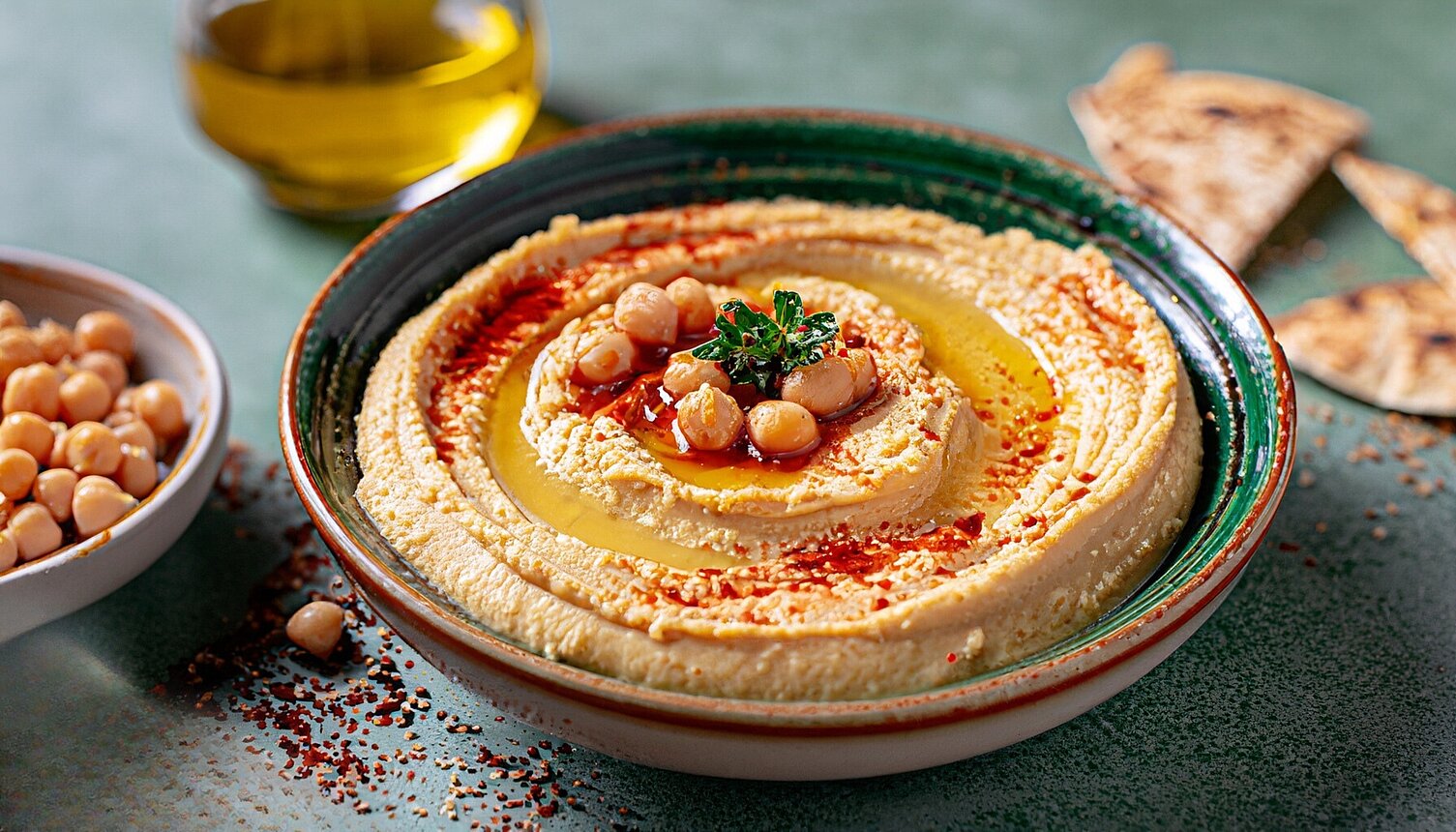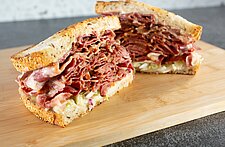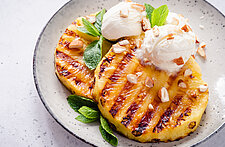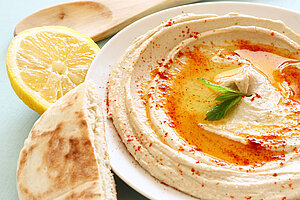 Middle Eastern foods like falafels, kebabs, flatbreads, and tabbouleh are gaining popularity in many markets. Newer generations are eager to introduce more global flavors into their everyday meals. So, it’s no surprise that consumers searching for bold flavors and rich, satisfying meals have found much to love in this cuisine.
Middle Eastern foods like falafels, kebabs, flatbreads, and tabbouleh are gaining popularity in many markets. Newer generations are eager to introduce more global flavors into their everyday meals. So, it’s no surprise that consumers searching for bold flavors and rich, satisfying meals have found much to love in this cuisine.
Another traditional food on the rise is hummus. This staple spread has been a cherished part of the Middle Eastern diet for centuries, with classic recipes fueling daily meals and offering nutritious, delicious flavors. Current flavor trends demonstrate hummus's increasing popularity.
Hummus on the Move From Middle Eastern Meals
Traditional dishes feature hummus as a dip served warm or cold. It can be a side dish or the main feature, accompanied by pita bread or other flatbreads. Chickpeas, or garbanzo beans, are the main base, pureed and mixed with tahini, garlic, and a bit of olive oil or lemon juice.
Original hummus, also called garlic hummus, is widely popular for its creamy bean texture and a hint of tang from roasted sesame seeds. Punchy garlic notes and fresh lemon enhance the flavor, while olive oil adds a smooth richness.
Consumers Are Shaping Their Hummus Preferences
Consumers are driven by several factors when seeking hummus products or menu offerings. The most important preference is taste.
Today’s consumers want intriguing flavors that make them curious about diverse cuisines. They want to try global flavors and aren't afraid to sample unusual combinations. This is all part of the immersive eating experience.
Nearly as important is health and wellness. Hummus is naturally a plant-based food, but the ingredients it’s paired with can influence the consumer’s dietary choices. Consumers focused on wellness may avoid certain foods or keep their palate focused on a specific diet.
Distribution also factors into consumer preferences for hummus consumption. Some consumers are driven by local production and distribution, while others want global flavors from authentic sources. Since these preferences are so different, operators tend to choose one or the other when creating hummus products.
Healthy ingredients and careful preparation are widely appealing to consumers across the market. Healthy foods have been trending for a while, but social and environmental connections are also increasingly important. Many consumers believe that how something is made is as important as its environmental impact.
Finally, modern consumers are driven by new and innovative foods. Social media and international travel have shown how diverse and exciting different cuisines are, and consumers want to experience these flavors for themselves. Hummus is gaining interest for its seemingly infinite combinations and flavors.
Current Hummus Trends
Moving beyond the main dish, hummus is gaining prominence in different menu offerings, including add-ons, sides, and kids’ menu choices. While appetizer usage has grown slightly, the biggest gains are as add-ons. This customization of menu items has strong consumer appeal because it lets people tailor foods to their tastes and enjoy a more unique dining experience.
Hummus is no different. Offering hummus as an add-on lets people experiment with flavors and find new foods that can become go-to favorites.
Related: Snack Trends: Conscious Snacking & a Bit of Indulgence
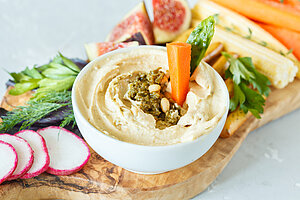 Sides and Kids’ Menus
Sides and Kids’ Menus
Current side trends are to pair hummus dip with different foods, such as fruits, vegetables, naan and pita bread, focaccia, or other “holdable” foods.
Hummus has a nutty, earthy flavor profile with tangy finishing notes. This complexity of hummus flavors gives it many possibilities, whether paired with dried apricots, apples, dates, strawberries, or another fruit.
Hummus and vegetables are a classic pairing, but new combinations like sweet potato, avocado, or jicama provide bolder flavors and different profiles. Another trend pairs hummus with focaccia bread. Here, the creamy bean notes of hummus blend with the grassy nuttiness of olive-oil-infused focaccia.
On kids’ menus, common ways to enjoy this spread are as a classic veggie dip, a layer in tacos, or a spread in pinwheel sandwiches. We also see versatility in how the hummus is prepared in kids’ menus. Sometimes, the tangy tahini is replaced with a more familiar nut or seed butter, such as pumpkin seed or cashew.
Main Entrees
Hummus continues to be part of main entrees, although the types of dishes offered are becoming more diverse.
So, what are operators creating? Here are just a few examples:
-
Rice or quinoa bowls with hummus, chicken, roasted corn, and balsamic date vinaigrette dressing
-
Hummus with ground beef, kalamata olives, sun-dried tomatoes, and feta cheese for a fresh Mediterranean flavor
-
Hummus served over farro or bulgur with roasted kale, broccoli, winter squash, pumpkin seeds, and za’atar-spiced chicken
-
Veggie sandwiches with hummus spread; any combination works, especially avocado, cucumber, bell pepper, pickled onions, and feta cheese
-
Spiced chicken, hummus, and sliced tomato on a toasted ciabatta or a sub roll
-
Grilled cheese variations, with hummus layered alongside caramelized onions, mushrooms, and Swiss cheese
Top Flavor Profiles
What do we see for top hummus flavors? The most common pairing is with traditional Mediterranean ingredients. Here, the fresh flavors of parsley, thyme, mint, and rosemary marry with the punchy notes of black pepper, garlic, and chili pepper.
Tomatoes, olive oil, and olives are other classic flavors with bright, complex flavor profiles. Layered flavors work exceptionally well with hummus's complex notes, with variations adding more flavors from pine nuts, shallots, or oregano.
Other popular pairings include classics like garlic and lemon juice. Along with these familiar favorites are top flavors that bring the freshness of cucumber, the sweet heat or earthy sweetness of peppers, or the tanginess of Greek flavors — especially feta, eggplant, and spinach.
Get the latest trends and more! Sign up for our newsletter now
Fast-Growing Hummus Flavors
While classic flavors have widespread popularity, there are many unique hummus flavors to explore as well. The fastest-growing flavor pairings look to the Mediterranean — specifically, to the salty tang of feta cheese and the grassy yet sweet notes of celery.
Other flavor pairings rising in popularity include onion's pungent sweetness, carrot's earthiness, and roasted garlic's more mellow and sweet notes. Pairing these flavors with hummus adds more complexity to the product. It blends well with modern consumer preferences for new flavors and exciting combinations.
Operator Usage of Ingredients and Flavors
The ingredients operators use with hummus typically depend on their stage within the industry.
Innovators aren’t afraid to experiment with new flavors. This is where we see bold combinations with pomegranate, lime, wasabi, and yuzu notes. Lebanese, Japanese, and Turkish cuisines play well in this chef-driven sector.
In the growth stage, high-end operators bring warm flavors to their offerings. Here, the stars of the show are honey, taro, oregano, and Spanish flavors like saffron, citrus, and red pepper.
Mainstream operators are driving the popular hummus market. In this sector, there’s a strong preference for lemon, garlic, cilantro, paprika, and sesame. These flavors and ingredients have solid appeal and pique the interest of many people.
Finally, in the mature market, we see the proven favorites that have been top flavors for the longest time. Here, the top ingredients come from Mediterranean and Greek cuisines, especially garlic, onion, cucumber, and carrot.
 Trends on the Rise
Trends on the Rise
Beyond hummus pairings, we see snack trends that bring innovation and exciting combinations. Hummus trends are becoming more versatile as the spread moves beyond its traditional origins.
Along with chickpea hummus, there’s a growing trend for hummus made from edamame or white beans. These beans and legumes bring plenty of nutrition and fiber, but their flavors are more nutty and often have a sweeter note.
Additional blends mix classic hummus with sweet potato or harissa spice. Hummus crisps and veggie chips are also infused with hummus for snack foods with exciting flavor profiles.
Are you ready for more hummus insights? Contact Symrise for more in-depth information on how to bring these flavors to your product offerings.
